Picture this: you’re scrolling through your favorite website, reading the latest news or checking out product reviews, when suddenly a colorful, eye-catching advertisement captures your attention. That’s the power of display advertising in action, and it’s generating over $200 billion in revenue globally as of 2024.
Display ads have been the backbone of digital marketing for decades, but they’ve evolved far beyond those simple banner ads we used to see everywhere. Today’s display advertising is smarter, more targeted, and incredibly effective when done right. Modern display campaigns achieve average conversion rates of 2.35% according to HubSpot’s 2024 Marketing Statistics.
Whether you’re a small business owner looking to expand your reach or a marketing professional wanting to master the latest strategies, this comprehensive guide will walk you through everything you need to know about display advertising. We’ll cover the basics, dive into advanced tactics, and share real-world insights that’ll help you create campaigns that actually work.
What Are Display Ads?
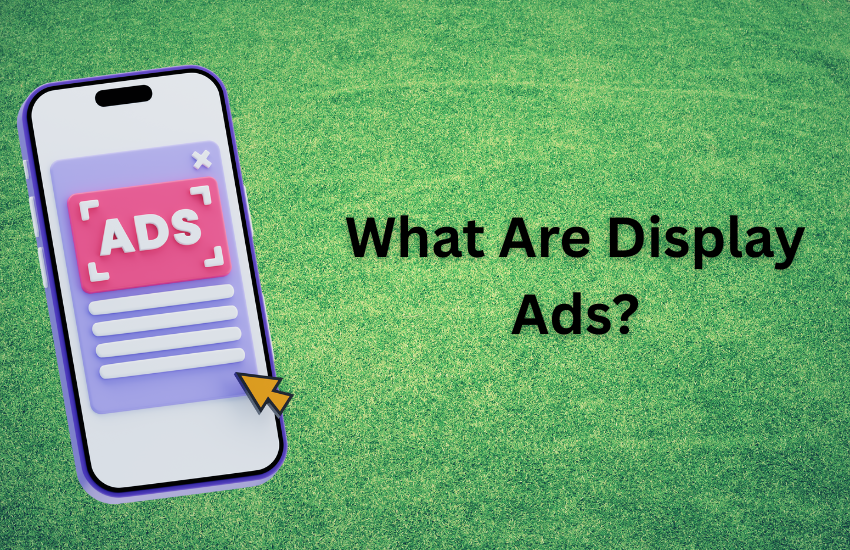
Display ads are visual-based digital advertisements that appear on websites, apps, and other digital platforms. Think of them as the digital equivalent of billboards – they’re designed to catch your eye and communicate a brand message quickly and effectively.
Unlike search ads that appear when someone types in specific keywords, display ads show up while people are browsing content, watching videos, or using apps. They often come in banner, image, video, or interactive formats to attract attention and promote brand messages. According to Google’s Display Network data, these ads reach over 90% of global internet users across 2 million websites.
“Display advertising is about being present when your audience is most receptive, not just when they’re actively searching.” – Neil Patel, NeilPatel.com
What makes display ads particularly powerful is their ability to reach people at different stages of the customer journey. Maybe someone has never heard of your brand before, or perhaps they visited your website but didn’t make a purchase. Display ads can help in both scenarios.
How Display Ads Work
The magic behind display ads happens through sophisticated ad networks and programmatic advertising platforms. Here’s how it works in simple terms:
When you create a display ad campaign, you’re essentially entering a massive digital marketplace. Ad networks like the Google Display Network act as intermediaries, connecting advertisers (like you) with website publishers who have ad space available.
Display ads are placed through these ad networks and delivered based on targeting options like demographics, interests, and behavior. The system uses real-time bidding to determine which ads appear in which spots, all happening in milliseconds as a webpage loads. This process handles over 10 million bid requests per second according to AdNgin’s 2024 Programmatic Report.
Modern display advertising leverages artificial intelligence and machine learning to optimize ad placement automatically. This means your ads are more likely to be shown to people who are genuinely interested in what you’re offering.
Where Display Ads Appear
One of the biggest advantages of display advertising is the sheer reach it offers. Your ads can appear across millions of websites and digital properties, including:
- Websites across the Google Display Network – This includes over 2 million sites, reaching more than 90% of internet users worldwide
- Mobile apps – From gaming apps to productivity tools, your ads can reach users while they’re engaged with their favorite mobile experiences
- YouTube – Both as video ads and display ads that appear alongside video content
- Gmail – Ads that appear in users’ email inboxes, blending naturally with their email experience
- Embedded in third-party platforms – News sites, blogs, e-commerce platforms, and specialized industry websites
The key is choosing the right placements for your specific audience. A B2B software company might focus on professional websites and LinkedIn, while a fashion brand might prioritize lifestyle blogs and Instagram.
Benefits of Display Advertising
Display advertising offers unique advantages that make it an essential part of any comprehensive digital marketing strategy. Let’s explore why so many businesses swear by display ads:
Boosts brand awareness and visibility: Display ads are fantastic for getting your brand in front of new audiences. Even if people don’t click on your ad immediately, they’re seeing your brand name, logo, and messaging. This repeated exposure builds familiarity and trust over time. Studies show that display ads increase brand awareness by 6.6% on average according to Google’s Think with Google research.
Great for retargeting previous site visitors: Here’s where display ads really shine. You can show targeted ads to people who have already visited your website but didn’t convert. These warm leads are much more likely to come back and make a purchase when they see your ad again. Retargeting campaigns typically see 10x higher click-through rates compared to standard display campaigns.
“Retargeting through display ads is like having a second chance to make a first impression – and it works incredibly well.” – Brian Dean, Backlinko
Generates leads and conversions over time: While display ads might not have the immediate conversion rates of search ads, they excel at nurturing prospects through longer sales cycles. They keep your brand top-of-mind throughout the buyer’s journey.
Cost-effective reach across a broad audience: Display advertising often offers lower cost-per-impression rates compared to other advertising channels, making it an efficient way to reach large audiences without breaking the budget. Average CPMs for display ads range from $1-5 according to HubSpot’s advertising cost analysis.
The compound effect of these benefits is powerful. When someone sees your display ad, searches for your brand later, and then converts, that original display ad played a crucial role in the conversion path – even if it wasn’t the final touchpoint.
Types and Formats of Display Ads
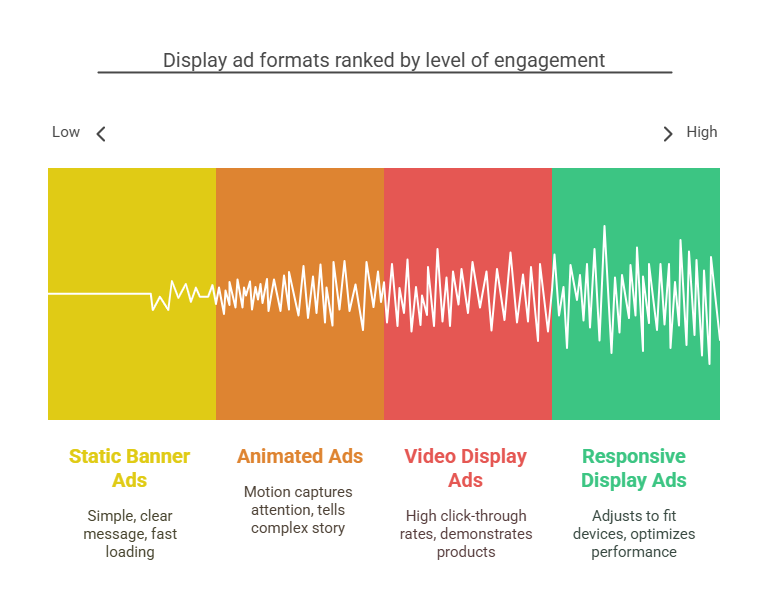
The world of display advertising offers incredible creative flexibility. Understanding the different formats available helps you choose the right approach for your campaign goals and audience preferences.
Static Banner Ads
Static banner ads are the classic format – simple image-based ads that don’t change or move. While they might seem basic compared to newer formats, they’re still incredibly effective when designed well.
The beauty of static banners lies in their simplicity and fast loading times. They work particularly well for brand awareness campaigns where you want to communicate a clear, straightforward message. Think of them as digital billboards that need to convey your value proposition at a glance.
Best practices for static banner ads include using high-contrast colors, minimal text, and a clear call-to-action. Remember, people typically see these ads for just a few seconds, so every element needs to work hard to grab attention and communicate value.
Animated Ads
Animated ads use motion or transitions to capture attention and can significantly outperform static ads in terms of engagement. The movement naturally draws the eye and allows you to tell a more complex story within the ad space.
These ads can showcase multiple products, demonstrate features, or create engaging narratives that unfold over a few seconds. However, there’s a fine line between eye-catching and annoying – subtle animations often work better than flashy, distracting movements.
When creating animated display ads, consider the user experience. Ads that are too busy or aggressive can actually hurt your brand perception. The goal is to enhance your message, not overwhelm your audience.
Video Display Ads
Video display ads are promotional videos that play within or around video content, and they’re becoming increasingly popular as internet speeds improve and video consumption grows. Video ads have 27x higher click-through rates than standard banner ads according to HubSpot’s Video Marketing Report 2024.
These ads can appear as pre-roll (before video content), mid-roll (during longer videos), or as standalone video ads on websites and apps. They’re particularly effective for demonstrating products, sharing customer testimonials, or telling brand stories.
The key to successful video display ads is hooking viewers within the first few seconds. Many platforms allow users to skip ads after 5 seconds, so your opening needs to be compelling enough to make people want to keep watching.
Responsive Display Ads
Responsive display ads automatically adjust size, appearance, and format to fit across devices and placements. This is Google’s answer to the complexity of creating multiple ad sizes for different placements.
With responsive ads, you provide multiple headlines, descriptions, and images, and Google’s machine learning automatically combines these elements to create ads that fit available spaces and perform well with different audiences.
This format saves time and often improves performance because the system can test different combinations and optimize for the best results. It’s particularly valuable for advertisers who want broad reach without the complexity of managing dozens of different ad sizes.
Modern Display Ad Strategies
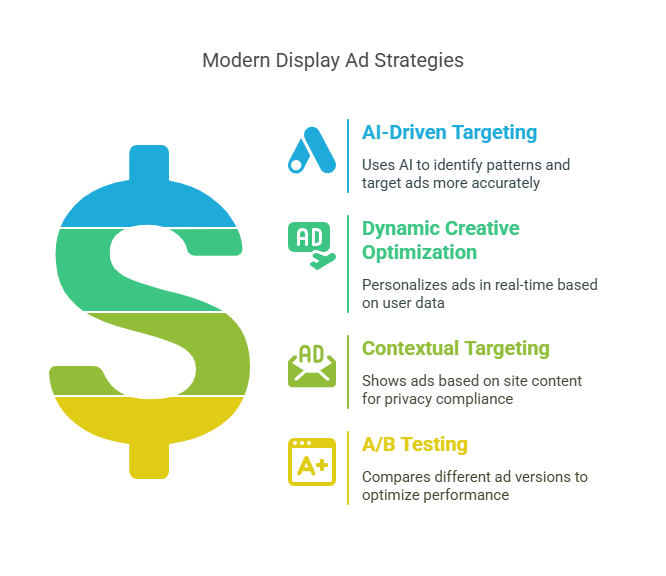
The display advertising landscape has evolved dramatically in recent years. Today’s most successful campaigns leverage advanced technologies and sophisticated targeting methods that were unimaginable just a few years ago.
AI-Driven Targeting
Artificial intelligence has revolutionized display advertising by enabling machines to identify patterns and make targeting decisions faster and more accurately than humans ever could.
AI-driven targeting uses machine learning to show ads to people most likely to convert based on behavior, interests, and demographics. The system analyzes millions of data points to predict which users are most likely to engage with your ads and take desired actions. AI-powered campaigns show 37% better performance than manual targeting according to Google’s AI advertising research.
“AI in display advertising isn’t just about automation – it’s about discovering audience insights that human analysis would never uncover.” – Rand Fishkin, SparkToro
What’s particularly exciting about AI targeting is its ability to discover unexpected audience segments. You might find that your product appeals to demographics you never considered, or that certain interests correlate strongly with conversions in ways that weren’t obvious before.
To leverage AI targeting effectively, focus on providing the algorithm with clear conversion data and sufficient budget to learn and optimize. The more quality data you feed the system, the better it becomes at finding your ideal customers.
Dynamic Creative Optimization (DCO)
Dynamic Creative Optimization automatically personalizes creatives in real-time based on user data, context, or location. Imagine showing different product recommendations to different users, or displaying local store information based on someone’s geographic location.
DCO takes personalization to the next level by creating essentially unlimited ad variations. A travel company might show beach destinations to users browsing during winter months, while displaying ski resorts to users in mountainous regions. DCO campaigns typically achieve 30-50% higher conversion rates than static campaigns.
The technology works by combining different creative elements – headlines, images, offers, and calls-to-action – based on what the system knows about each individual user. This level of personalization often leads to significantly higher engagement rates and conversions.
Contextual Targeting
With growing privacy concerns and the deprecation of third-party cookies, contextual targeting is making a strong comeback. This strategy shows ads based on site content rather than user data, making it perfect for navigating our privacy-first future.
Contextual targeting works by analyzing the content of web pages and matching ads to relevant topics. If someone is reading an article about home improvement, they might see ads for tools, furniture, or home services.
This approach offers several advantages: it’s privacy-compliant, brand-safe (your ads appear alongside relevant content), and often highly effective because it reaches people when they’re already thinking about related topics. Contextual targeting effectiveness has increased by 42% since cookie deprecation began according to Google’s Privacy Sandbox research.
A/B Testing
A/B testing in display advertising involves comparing different ad versions to determine which layout, message, or call-to-action performs best. This scientific approach to optimization can dramatically improve campaign performance over time.
Effective A/B testing goes beyond just changing colors or headlines. Test different value propositions, imagery styles, ad formats, and targeting approaches. The insights you gain can inform not just your display campaigns, but your overall marketing strategy.
Remember to test one element at a time for clear results, ensure statistical significance before drawing conclusions, and always be testing something. The digital landscape changes constantly, and what worked last month might not work today.
Targeting and Segmentation Techniques
The success of your display advertising campaigns largely depends on showing the right message to the right people at the right time. Modern targeting capabilities are incredibly sophisticated, allowing you to reach highly specific audiences with precision.
Interest and Affinity-Based Targeting
Interest and affinity-based targeting allows you to reach users who have expressed interest in topics related to your niche. This goes beyond simple demographics to focus on actual behaviors and stated interests.
For example, instead of just targeting “women aged 25-35,” you could target “women who have shown interest in sustainable fashion, yoga, and organic food.” This creates much more relevant audience segments that are likely to resonate with your brand message.
The key is understanding that interests exist in clusters. Someone interested in fitness might also be interested in healthy cooking, outdoor activities, and wellness products. Mapping these interest connections helps you build more comprehensive targeting strategies.
Lookalike and Similar Audiences
Lookalike audiences use existing customer data to find new users that behave like your best customers. This is one of the most powerful targeting options available because it’s based on actual conversion data from your business.
The process works by analyzing the characteristics, behaviors, and interests of your existing customers, then finding other users who share similar traits. The algorithm can identify patterns that humans might miss, leading to highly qualified prospect lists. Lookalike audiences typically achieve 3x higher conversion rates than broad targeting according to Meta’s advertising insights.
To create effective lookalike audiences, start with your highest-value customers rather than just any customers. Use data from people who have made multiple purchases, have high lifetime value, or represent your ideal customer profile.
Remarketing
Remarketing allows you to re-engage users who have already interacted with your site or ads. This is often the highest-converting form of display advertising because you’re targeting warm leads who have already shown interest.
Effective remarketing goes beyond just showing the same ad to everyone who visited your website. Segment your remarketing lists based on behavior: people who viewed specific products, users who abandoned shopping carts, visitors who spent significant time on your site, and past customers you want to re-engage.
“Smart remarketing is about understanding intent signals and responding with the right message at the right time.” – Tim Soulo, Ahrefs
Create different messaging for different segments. Someone who abandoned a shopping cart might respond to a discount offer, while someone who just discovered your brand might need more educational content about your products’ benefits.
First-Party Data Targeting
First-party data targeting utilizes your own audience data – email lists, CRM information, website analytics – to build privacy-compliant advertising campaigns. This approach is becoming increasingly important as third-party cookies disappear.
Your first-party data is incredibly valuable because it’s based on real interactions with your business. You can upload customer email lists to create targeted campaigns, or use website visitor data to build custom audiences. First-party data campaigns show 2.9x higher revenue per visitor according to Google Analytics Intelligence reports.
The beauty of first-party data is that it’s completely under your control and fully privacy-compliant. Plus, it often provides better results than third-party data because it’s more accurate and relevant to your specific business.
Key Metrics to Track
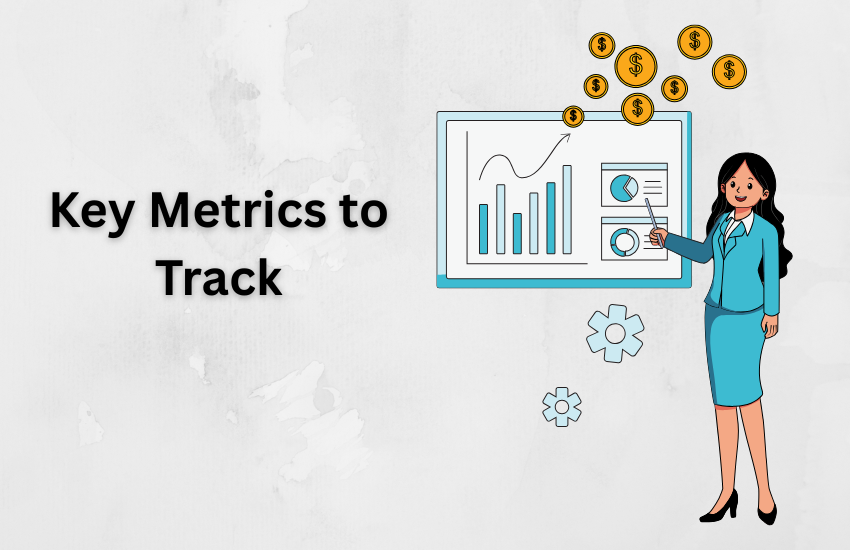
Measuring the success of your display advertising campaigns requires tracking the right metrics and understanding what they actually mean for your business goals. Here are the essential metrics every display advertiser should monitor:
Impressions & Click-Through Rate (CTR): Impressions tell you how many times your ads were shown, while CTR measures the percentage of people who clicked on your ads. While CTR is important, don’t obsess over it – display ads often provide value through impressions alone, building brand awareness even when people don’t click. Average display CTR across all industries is 0.46% according to Google Ads benchmarks 2024.
Viewability Rate: This metric measures whether your ads were actually seen by users. An ad might load on a webpage but appear below the fold where users don’t scroll. Viewability rates above 70% are generally considered good, though this varies by placement and industry.
Engagement Rate: Beyond clicks, engagement includes interactions like video views, expansions of rich media ads, or time spent viewing your content. High engagement rates often indicate that your creative resonates well with your target audience.
Conversion Rate: The percentage of users who complete desired actions after seeing or clicking your ads. This is where display advertising proves its business value – tracking not just clicks, but actual business outcomes like sales, sign-ups, or downloads.
Return on Ad Spend (ROAS): Perhaps the most important metric for business owners, ROAS measures how much revenue you generate for every dollar spent on advertising. A ROAS of 4:1 means you earn $4 for every $1 spent on ads. Top-performing display campaigns achieve ROAS of 8:1 or higher.
Remember to look at these metrics in context. A low CTR might be fine if your viewability and brand awareness are strong. Similarly, a campaign with lower immediate conversions might be building valuable remarketing audiences for future campaigns.
Display Ads vs. Search & Social Ads
Understanding how display advertising compares to other digital advertising formats helps you make smarter decisions about where to allocate your marketing budget and how to structure your overall strategy.
| Display Ads | Search Ads | Social Ads | |
|---|---|---|---|
| When They Show | Passive browsing | User search intent | While scrolling feeds |
| Formats | Image, video, interactive | Text-heavy | Image, video, carousel |
| Best For | Awareness + Remarketing | High-intent leads | Engagement and branding |
| Average CTR | 0.46% | 3.17% | 0.90% |
| Average CPC | $0.63 | $2.69 | $1.72 |
Each format serves different purposes in your marketing funnel. Search ads are excellent for capturing demand that already exists – when someone searches for “best running shoes,” they’re ready to buy. Display ads are better at creating demand and nurturing prospects over time.
Social ads fall somewhere in between, offering powerful targeting capabilities and high engagement potential, but within the more limited context of social media platforms.
The most successful digital marketing strategies use all three formats strategically. Display ads might introduce new audiences to your brand, search ads capture them when they’re ready to buy, and social ads maintain engagement throughout the process.
Challenges and Privacy Considerations
The display advertising landscape is evolving rapidly, driven by privacy regulations, changing consumer expectations, and technological developments. Understanding these challenges helps you build more resilient, future-proof campaigns.
Cookie Deprecation
Third-party cookies, which have been the foundation of display advertising targeting for decades, are going away. Major browsers are phasing them out, and this shift is fundamentally changing how display advertising works.
The solution isn’t to panic, but to shift focus to first-party data, contextual targeting, and clean-room technologies that enable privacy-compliant audience insights. Businesses that adapt early to these changes will have significant advantages over competitors who wait. 89% of marketers are now investing in cookieless solutions according to Google’s Privacy Sandbox update.
Start building your first-party data collection strategies now. Encourage email sign-ups, create valuable content that requires registration, and use progressive profiling to gradually learn more about your audience in ways they’re comfortable with.
Ad Fatigue
Ad fatigue occurs when audiences see the same ads too frequently, leading to declining performance and potentially negative brand perception. This is particularly challenging in remarketing campaigns where you’re repeatedly targeting the same users.
Combat ad fatigue by rotating creatives and formats regularly to keep ads fresh and engaging. Set frequency caps to limit how often the same person sees your ads, and create multiple creative variations that can be rotated automatically.
Monitor your campaign metrics for signs of ad fatigue – declining CTRs, increasing CPCs, or negative feedback. When you spot these warning signs, refresh your creative or adjust your targeting to reach new audiences.
Ad Blockers
A significant portion of internet users employ ad blockers, which can limit the reach of traditional display advertising. 27% of internet users actively use ad blockers according to Hootsuite’s Digital Advertising Report 2024. While this is challenging, it’s also an opportunity to improve your advertising approach.
Focus on creating ads that provide genuine value to users. Use native-looking elements and value-based content that people might actually want to see. The goal is to make ads that are so useful or entertaining that people wouldn’t want to block them.
Consider alternative approaches like sponsored content, influencer partnerships, or content marketing that naturally integrates with the user experience rather than interrupting it.
Real-World Case Studies
Learning from real examples helps bridge the gap between theory and practice. Here are some compelling case studies that demonstrate the power of well-executed display advertising strategies:
Case Study: How Company A Increased ROAS by 3x Using Dynamic Display Ads
An e-commerce retailer was struggling with generic display ads that showed the same products to all users. By implementing dynamic creative optimization, they were able to show personalized product recommendations based on users’ browsing history and purchase behavior.
The results were dramatic: their return on ad spend increased from 2:1 to 6:1 within three months. The key was using their extensive product catalog and customer data to create highly relevant, personalized ad experiences that felt more like helpful recommendations than traditional advertising.
Example: Brand B Reduced CPA by 40% Through AI Targeting
A software company was spending heavily on broad demographic targeting with mediocre results. They switched to AI-powered audience targeting that analyzed behavioral patterns and identified unexpected audience segments that were highly likely to convert.
The AI discovered that their ideal customers often visited specific industry websites and showed interest in particular topics that weren’t obviously related to their software. By targeting these behavioral signals instead of basic demographics, they reduced their cost per acquisition by 40% while increasing overall conversion volume.
Benchmark: Average CTR for Display Ads in 2024 by Industry
Understanding industry benchmarks helps you evaluate your campaign performance realistically. Current data shows that average display ad CTRs vary significantly by industry: technology companies often see 0.4-0.6%, retail businesses typically achieve 0.6-0.8%, and travel/hospitality can reach 0.8-1.2%.
However, don’t get too focused on matching industry averages. A campaign with a lower CTR but higher conversion rate and better ROAS is infinitely more valuable than one with high clicks but no business results.
Best Tools and Platforms
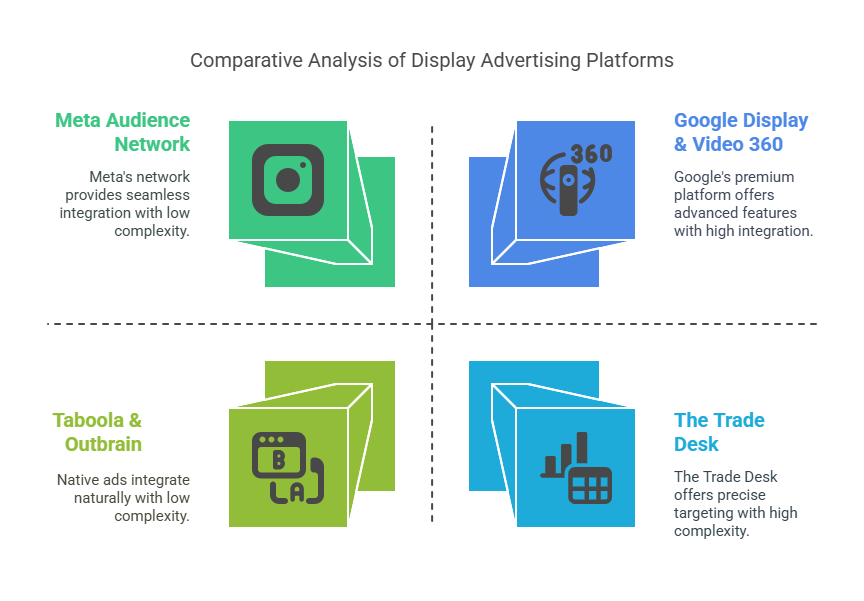
Choosing the right tools and platforms can make or break your display advertising success. Here are the top options that professional marketers rely on:
Google Display & Video 360: This is Google’s premium demand-side platform that offers advanced targeting, creative optimization, and cross-channel campaign management. It’s particularly powerful for large-scale campaigns and businesses that need sophisticated audience insights.
The platform excels at integrating with other Google products and provides access to premium inventory across the web. However, it’s complex and typically requires significant expertise or agency support to use effectively.
Meta Audience Network: This extends your Facebook and Instagram campaigns to apps and websites beyond Meta’s own properties. It’s particularly effective for mobile-focused campaigns and businesses that have strong performance on Facebook and Instagram.
The advantage is seamless integration with Meta’s powerful targeting capabilities and creative tools. You can essentially extend your successful social campaigns to a broader display network.
Taboola & Outbrain (native display): These platforms specialize in native advertising that appears as recommended content rather than traditional banner ads. They’re particularly effective for content marketing campaigns and businesses with engaging, educational content.
Native ads typically achieve higher engagement rates because they integrate naturally with editorial content. They work especially well for driving traffic to blog posts, whitepapers, and other valuable content resources.
Programmatic platforms like The Trade Desk: These sophisticated platforms use real-time bidding to purchase ad inventory across thousands of websites and apps. They offer incredible targeting precision and are preferred by many large brands and agencies.
The Trade Desk and similar platforms provide transparency into where your ads are running, detailed performance analytics, and access to premium publisher inventory. They require more expertise but offer maximum control and optimization potential.
FAQs About Display Ads
Let’s address some of the most common questions that businesses have about display advertising:
Are display ads worth it?
Absolutely – especially when combined with retargeting, AI-driven optimization, and branding strategies. While display ads might not provide the immediate gratification of search ads, they’re invaluable for building brand awareness, nurturing prospects, and supporting your entire marketing funnel.
The key is setting appropriate expectations and measuring the right metrics. Display ads excel at introducing new audiences to your brand and keeping you top-of-mind throughout longer purchase cycles. Companies using display ads see 155% increase in brand searches according to recent industry research.
How much do display ads cost?
Display ad costs vary significantly based on targeting, placement, and competition. Typical CPMs (cost per thousand impressions) range from $1–$5, though premium placements or highly competitive audiences can cost much more.
The beauty of display advertising is that you can start with almost any budget. Begin small, test what works, and scale up the campaigns that deliver good returns. Many successful display campaigns start with just $10-20 per day.
How can I improve my display ad performance?
Focus on these proven strategies:
- Use compelling images and short copy: Your ad needs to communicate value within seconds. High-quality visuals and concise, benefit-focused copy are essential.
- Test multiple creatives and headlines: What resonates with one audience segment might not work for another. Continuous testing helps you find the combinations that perform best.
- Refine targeting based on data: Start broad to gather data, then narrow your targeting based on which audiences actually convert. Use this data to create lookalike audiences and exclude non-performing segments.
“The most successful display campaigns are built on a foundation of continuous testing and data-driven optimization.” – Barry Schwartz, Search Engine Land
Remember that display advertising is often about the cumulative effect of multiple touchpoints rather than immediate conversions. Focus on building a comprehensive strategy rather than expecting instant results from individual ads.
Wrap-Up: Are Display Ads Right for You?
After diving deep into the world of display advertising, you might be wondering whether this channel makes sense for your specific business and goals.
Display ads are particularly valuable if you want to grow awareness, retarget users, or scale with automation – and optimize for today’s privacy-first web. They’re especially effective for businesses with longer sales cycles, visual products, or brands that benefit from repeated exposure.
However, display advertising isn’t a magic bullet. It works best as part of a comprehensive digital marketing strategy that includes search marketing, content creation, and conversion optimization. The businesses that see the best results treat display ads as one piece of a larger puzzle rather than a standalone solution.
If you’re ready to start with display advertising, begin small and focus on learning. Set up remarketing campaigns for your website visitors, test different creative approaches, and gradually expand your targeting as you gather data about what works for your audience. The future of display advertising is bright, with new technologies making campaigns more effective and privacy-compliant than ever before.
Internal Resources
Continue your digital marketing education with these related resources:
- Programmatic Advertising 101 – Dive deeper into automated ad buying and optimization
- First-Party Data Strategies for Marketers – Learn how to build privacy-compliant audience insights
- How to Boost Your ROAS with Smarter Ad Targeting – Advanced techniques for improving campaign profitability


